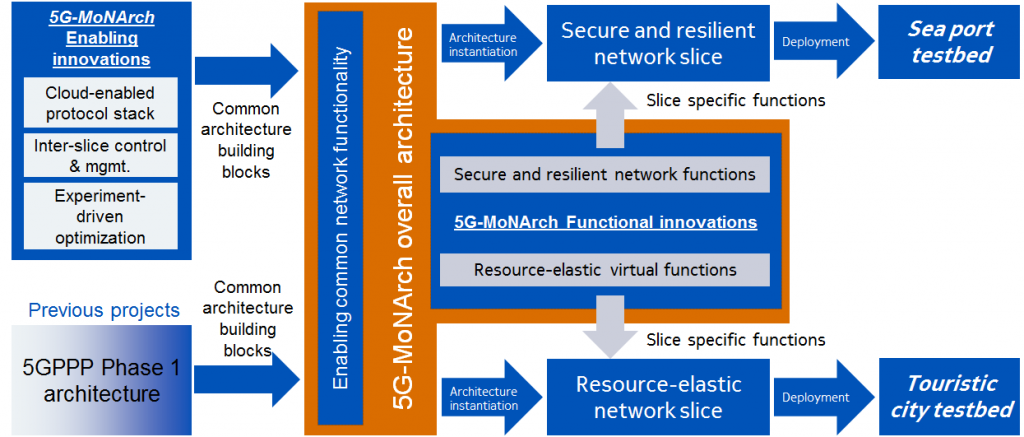A summary document on the main results and achivements of 5G-MoNArch can be downloaded here.
A project flyer providing a brief overview about the key approach and goals of 5G-MoNArch can be downloaded here.
The expected diversity of services and use cases in 5G requires a flexible, adaptable, and programmable architecture. While the design of such an architecture has been addressed by 5G-PPP Phase 1 projects at a conceptual level (for example, 5G-NORMA and METIS II), it must be brought into practice in Phase 2. To this end, 5G-MoNArch will evolve 5G-PPP Phase 1 concepts to a fully-fledged architecture, develop prototype implementations and apply these prototypes to representative use cases.
5G MoNArch’s specific technical goal is to use network slicing, which capitalizes on the capabilities of software-defined networking (SDN), network functions virtualization (NFV), orchestration of access network and core network functions, and analytics, to support a variety of use cases in vertical industries such as automotive, healthcare, and media. Network slicing is a technique where the network is logically (not physically) sectorized, so that separate services are supported by each “separate” logical network. As 5G networks need to support simultaneously various services with different requirements, network slicing will be a crucial aspect of the network architecture, providing flexible and adaptive networks which fulfill the 5G requirements.
The 5G-MoNArch architecture design will enhance the Phase 1 concepts with three enabling innovations, which are worked out within work package 2:
- Inter-slice control and cross-domain management, to enable the coordination across slices and domains
- Experiment-driven optimization, to leverage experimental results to design highly performing algorithms
- Cloud-enabled protocol stack, to gain flexibility in the orchestration of virtualized functions
The devised 5G-MoNArch architecture will be deployed in two test beds: the Smart Sea Port, representing a vertical industry use case, and the Touristic City, representing a media and entertainment use case. For each test bed, 5G-MoNArch will instantiate the architecture and complement it with a use case specific functionality – the two functional innovations of 5G-MoNArch:
- Resilience and security, needed to meet the Smart Sea Port requirements; the corresponding innovations are worked out in work package 3.
- Resource elasticity, to make an efficient use of the resources in the Touristic City; the corresponding innovations are worked out in work package 4.

With this approach, 5G-MoNArch has a very high potential for commercial impact, including new or enhanced products such as orchestrators or edge-cloud Radio Access Networks (RAN), novel services for vertical industries that are enabled through network slicing, or even opportunities for new business concepts and market players in the area of mobile communications.
Work Packages
The overall approach of 5G-MoNArch is reflected in the work package structure of the project, where 5 technical work packages (WP 2 through 6) develop, implement and evaluate the architectural design and the technology innovations as introduced above. Two supporting work packages are responsible for project management and coordination (WP1), and for leveraging and organizing the exploitation, dissemination and standardization of project results (WP7). An overview figure about the work package structure is provided below
- Work Package 2: Flexible and Adaptive Architecture Design develops the overall flexible and adaptive network architecture, with incorporating the 5G-PPP Phase 1 projects’ design findings. A particular focus is put on developing the enabling innovations cloud-enabled protocol stack, inter-slice control and cross-domain management, and experiment-driven optimization. Finally, the functional innovations developed in work packages 3 and 4 are integrated in the architecture.
- Work Package 3: Resilience and Security has the main objective to develop network functions that ensure a fail-safe and secure mobile network operation even in situations with inadequate radio link quality. Applied technologies are, for example, multi-connectivity, or dedicated network coding and transmission schemes.
- Work Package 4: Resource Elasticity has the main objective to design a resource elasticity framework, which aims at improving the utilization efficiency of computational resources in the virtualized mobile network. Applied techniques are, for example, intelligent resource pool adjustments and graceful degradation in network function performance.
- Work Package 5: Test Beds will specify and implement the project’s two test beds as introduced above, namely, the Smart Sea Port and the Touristic City. Core goal is to prove the applicability of the same network architecture specification as developed in work package 2 in two instances with diverging requirements. The customization of the sea port test bed focuses on the results of work package 3, while the customization of the touristic city test bed focuses on the results of work package 4.
- Work Package 6: Verification and Validation supports and validates the research, design and implementation activities from work packages 2 through 4 and the test bed setups in work package 5. This includes the verification of the technical feasibility of the concepts, the achievement of the stakeholders’ requirements, and their economical viability, including the definition of relevant key performance indicators and the necessary verification and validation methods.
